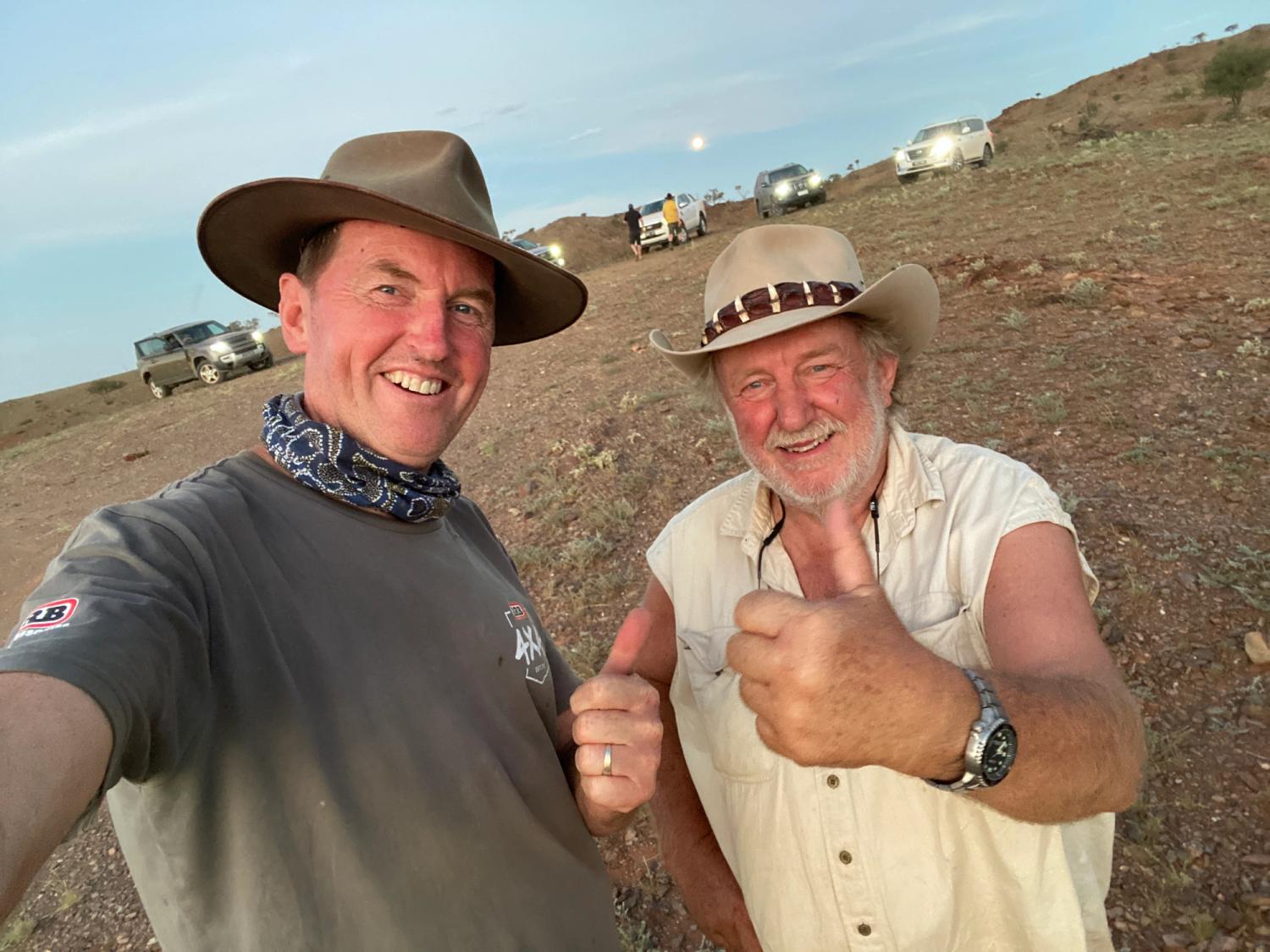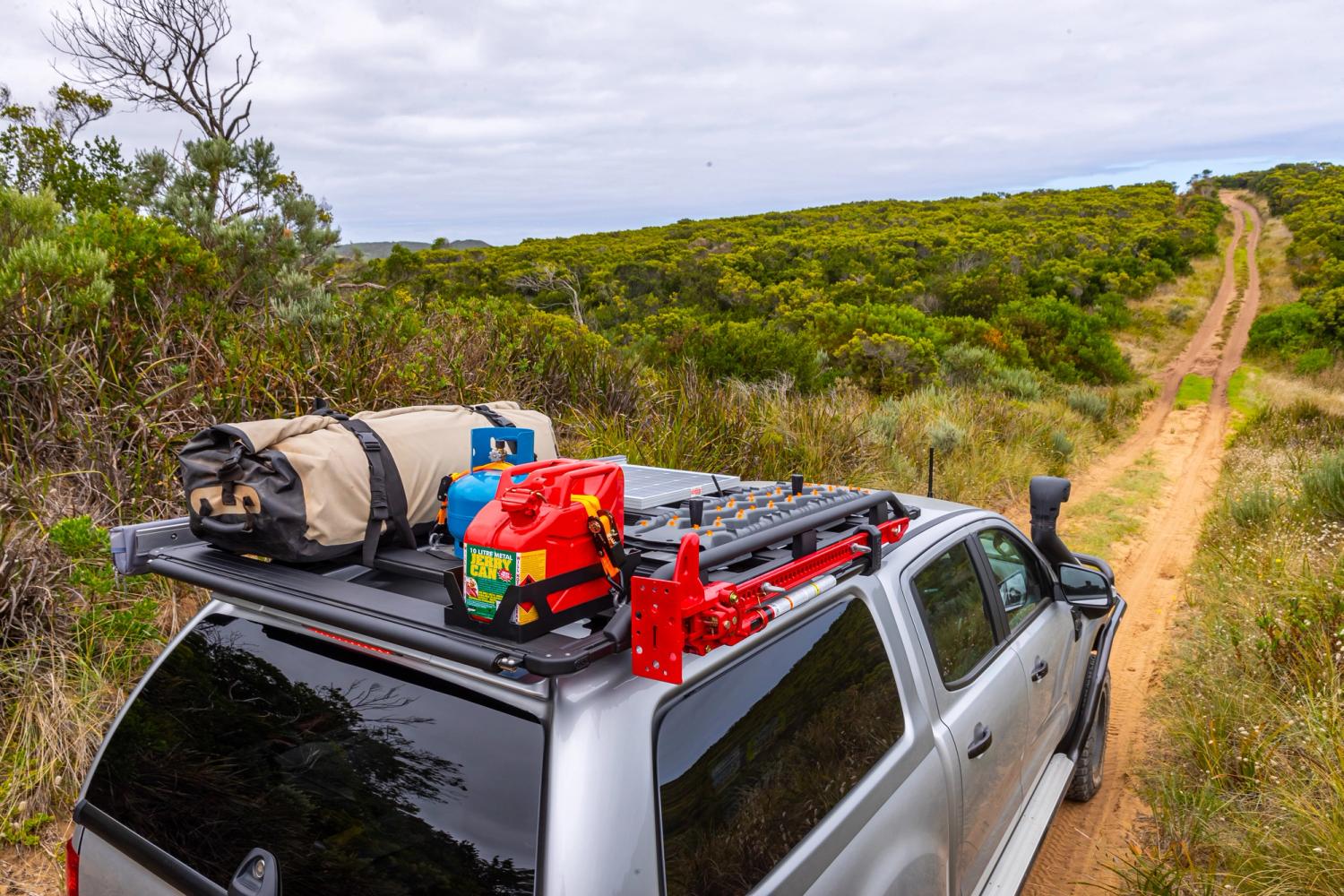Transporting fuel or gas with your 4WD requires careful consideration.
Once you've set up your 4WD and camping gear, you may find yourself needing to bring along gas for the camp kitchen and extra fuel for tools like your chainsaw.
Embarking on a 4WD adventure to your favourite spot might also mean packing additional fuel for remote journeys, such as crossing the Simpson Desert.

person tying down jerry can on roof rack
But what exactly should you purchase, and where's the safest spot to store these essentials while on the road?
Adding another layer of complexity is that Australia's regulations vary from state to state, and the abundance of, often conflicting,information available on the topic.
Anyone can stroll into a camping store and pick up fuel containers (jerry cans) of different sizes.These are typically made of plastic or steel and are available in various colours, making it easy to differentiate them from a distance.

landcruiser with roof rack spare tyre jerry can max trax
Ensure you purchase containers with Australian Standards ASNZS:2906 certification.
I recommend investing in high-quality fuel containers and storage solutions that meet your needs. Fuel containers are available in sizes ranging from five to 20 litres, so before purchasing assess your requirements, intended application, and storage space carefully. Quality is paramount, so prioritise containers with secure fittings to prevent leaks and ensure easy pouring.
While there's no official colour-coded system for Jerry Cans, labelling your containers and informing your travel companions about their contents can mitigate confusion.
Here's a simple guideline:
Petrol: Red or dark green
Diesel: Yellow or olive
Kerosene: Blue
2-stroke fuel: Green (though it's also used for petrol)
Water: Light blue or clear
Other colours may cause confusion, but bright green, for instance, is occasionally used to denote a specific type of fuel.

green petrol can
The lack of standardised colour-coding can lead to potential hazards, such as the need to smell the fuel for identification or difficulty distinguishing fuels in emergencies.
Similarly, gas bottle regulations vary, but opting for smaller bottles allows for safer transportation on your 4WD's roof or tray. Look for high-quality fittings that securely lock the bottle in place. While many caravans and camper trailers offer designated storage, always avoid transporting gas bottles inside your 4WD as there are significant safety risks involved.

ford ranger off-road with fuel and spare tyre on rear
It's truly frightening to witness the methods people employ to transport these volatile substances in or on their 4X4 vehicles.
Different states have different regulations regarding the transportation of fuel and gas bottles, so it's crucial to consult local authorities for specific guidelines. These regulations often specify limits on the amount of fuel that can be carried and where it can be stored.
When filling fuel containers like jerry cans, always place the container on the ground to ground it and reduce the risk of static electrical charges igniting the fuel.
Avoid overfilling containers to allow room for expansion in hot conditions. Leaving some air in the container, especially in a 20-litre container, accounts for expansion. Excessive heat can cause containers to swell and potentially leak.
After filling, ensure the cap or lid is securely fastened to prevent spillage.

camping with gas bottle and fuel on roof rack 4wd
For safety reasons, storing fuel outside of the vehicle in a secure location is ideal. Open-air environments like the back of a Ute are suitable for carrying fuel, but never transport fuel inside the cabin to minimise exposure to dangerous fumes.

person tying down gas bottle on 4wd roof rack camping
When carrying fuel or gas, always use high-quality straps or other secure devices to lock the fuel container in place safely.

gasmate tie down roof rack bracket gas bottle 4wd
While the placement of fuel containers might seem straightforward, it's essential to consider various factors. Avoid placing petrol containers in locations that could become volatile in the event of an accident, such as on the back of a caravan or 4WD.
Enclosed spaces can lead to a dangerous buildup of gases when storing fuel, so ensure there's adequate ventilation for any fuels being carried.
After use, inspect the containers for any cracks or damage that could affect their integrity on your next trip.

modified landcruiser 4wd offroad carrying gas on rear tailgate
For 4X4 enthusiasts, carrying a portable fire extinguisher is recommended. Ensure its easily accessible by considering mounting or storage options carefully.
Remember, you may only need to fill these fuel containers for specific sections of your journey. Plan accordingly and think about only filling the canisters before the sections where you'll truly need them. For instance, if traveling from the east coast to the Simpson Desert, you don't need to carry extra fuel for the entire trip; fill them at the last necessary point to avoid unnecessary weight for thousands of kilometres (and risk) heading west.

refilling 4wd with diesel on remote outback road
Make sure that you are transferring the fuel from the containers to your vehicle's fuel tank as soon as your gauge indicates there's room. This action shifts the weight from your roof to the lower centre of gravity location of your fuel tanks, which will only further enhance your vehicles stability.
“Cheers”
Michael Ellem | Offroad Images

michael ellem offroad images
Heading to outback & need insurance?
Our comprehensive insurance goes anywhere you're legally allowed to go, on-road and off.
The Campfire - Feedback
Just like sitting around the campfire, we would love to hear what you have to say.
Also… we will be featuring stories about photography tips and tricks, 4X4 preparation, build planning and maintenance, as well as featuring inspirational locations for you to visit in your 4X4. So please get involved and let us know what you’d like to hear about.
If you have any requests for stories to be featured in campfire or would like to provide feedback about this article, please send us a message on our social links…
Instagram: @offroadimages
Facebook: @offroadimages
YouTube: https://www.youtube.com/OffroadImages
Website: http://www.offroadimages.com.au
As 4X4 enthusiasts who live for the opportunity to create awesome imagery anywhere in Australia, we know that our vehicle assets are covered wherever we travel to create that shot, as we are insured by Club 4X4.


